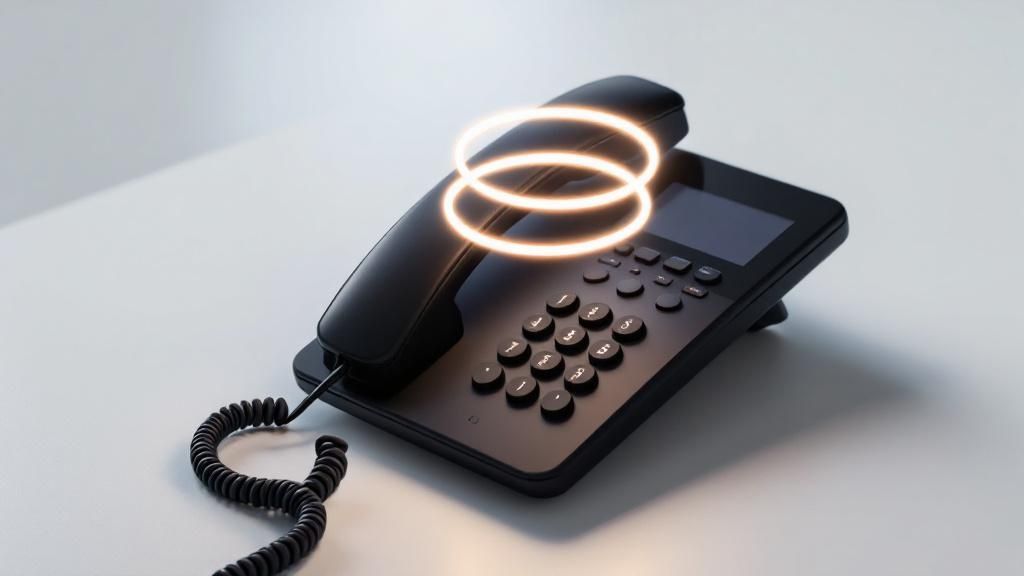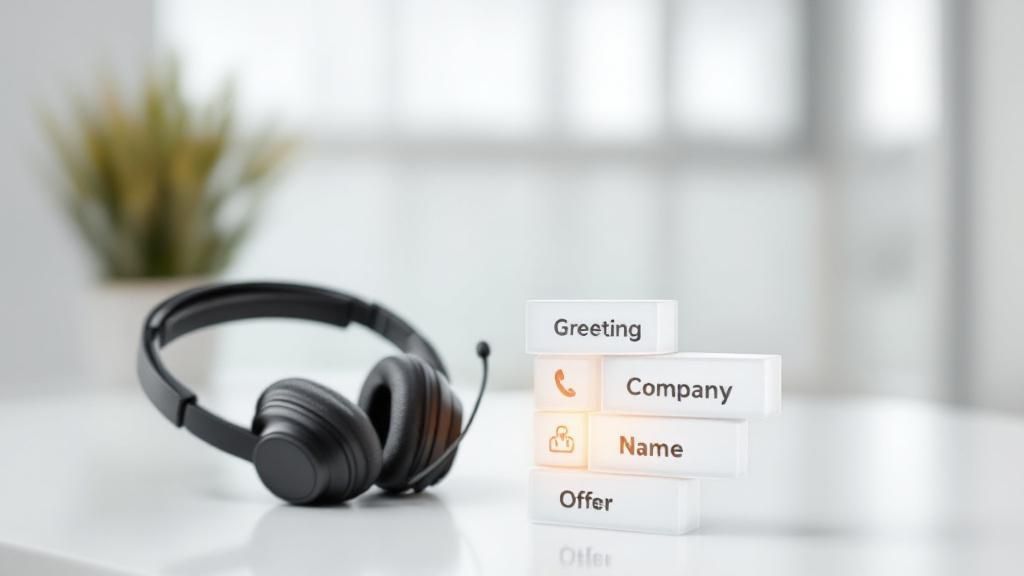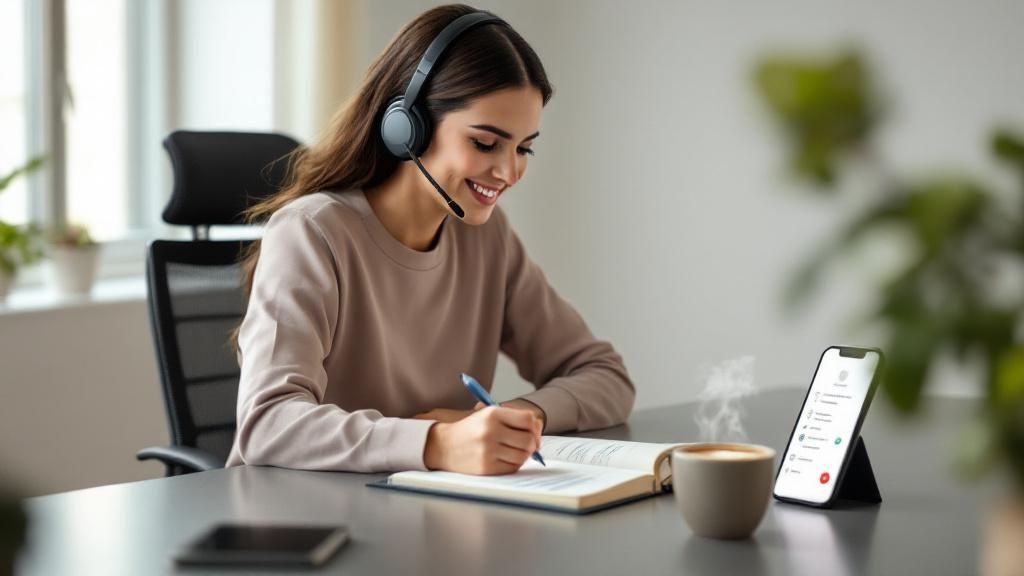Transforming Conversations: Why Phone Etiquette Matters in the Digital Age
This listicle delivers six key phone etiquette training strategies to enhance your professional communication. For busy professionals like mortgage brokers, real estate agents, property managers, trades professionals, and small business owners, effective phone skills are essential for success. These skills can transform simple calls into opportunities for building client relationships and closing deals. Learn how polished phone etiquette can differentiate you from the competition and boost your bottom line. This list provides actionable advice, moving beyond the basics to give you a real competitive edge.
This phone etiquette training will cover:
- The Three-Ring Rule
- Professional Phone Greeting Formula
- Active Listening and Note-Taking Techniques
- Professional Hold and Transfer Procedures
- Voice Modulation and Tone Control
- Effective Call Closing and Follow-up Protocols
Mastering these six elements of phone etiquette will empower you to project professionalism, build rapport, and leave a lasting positive impression. Each point offers practical, actionable steps you can implement immediately to improve your phone communication skills. Let's dive in and transform your conversations.
1. The Three-Ring Rule
The three-ring rule, a cornerstone of effective phone etiquette training, dictates answering calls within three rings. This seemingly simple practice projects professionalism and respects the caller's time, creating a positive first impression. It strikes a balance between avoiding a sense of being ignored and allowing the recipient adequate time to prepare for the conversation. Implementing this rule consistently elevates your business communication, particularly crucial for busy professionals in client-facing roles.

Why the Three-Ring Rule Matters for Your Business
In today's fast-paced business environment, responsiveness is key. For professionals like mortgage brokers, real estate agents, property managers, small business owners, and trades professionals, prompt communication can be the difference between securing a deal and losing a client. The three-ring rule ensures you capture every opportunity and demonstrates your commitment to client service. It positions your business as reliable and attentive, fostering trust and building strong client relationships.
Examples of Successful Implementation
Several organisations, renowned for their excellent customer service, have effectively incorporated the three-ring rule into their operations:
- Disney: Their customer service centres maintain this standard across all departments, ensuring a magical experience from the first interaction.
- Zappos: Known for their exceptional service model, Zappos call centres use the three-ring rule as a key element in creating positive customer interactions.
- Medical Offices: Implementing the three-ring rule in medical settings ensures patient concerns are addressed promptly, conveying care and efficiency.
Actionable Tips for Implementing the Three-Ring Rule
Integrating the three-ring rule into your daily operations is achievable with these practical tips:
- Utilise Call Routing Systems: Efficiently distribute calls to the appropriate team members, minimizing wait times and ensuring prompt responses.
- Train Multiple Staff Members: Equip multiple staff members with the skills to answer phones professionally, particularly during peak hours. This distributes the workload and maintains consistent adherence to the three-ring rule.
- Set Up a Professional Voicemail System: A professional voicemail system acts as a backup when calls cannot be answered immediately. Provide clear instructions and ensure messages are checked and returned promptly.
- Monitor Call Response Times: Regularly monitor your call response times to identify areas for improvement and ensure ongoing adherence to the three-ring rule. Use call analytics software or manual logs to track performance.
When and Why to Use This Approach
The three-ring rule is particularly beneficial in situations requiring prompt and efficient communication:
- Sales Calls: Responding quickly to sales inquiries increases the likelihood of conversion. A delayed response can result in lost opportunities and diminished customer interest.
- Customer Support: Addressing customer concerns promptly enhances satisfaction and builds loyalty. Quick resolutions demonstrate your commitment to their needs.
- Internal Communication: Efficient internal communication streamlines operations and fosters a collaborative work environment. Prompt responses facilitate smooth workflows.
The three-ring rule is more than just a phone etiquette tip; it's a strategic business practice that elevates your professionalism and enhances client relationships. Its implementation reinforces your dedication to exceptional service, differentiating you from competitors and fostering long-term success. By adhering to this principle, Australian professionals across various industries can cultivate a positive and responsive brand image, strengthening their position in the market. While Dale Carnegie training programs and customer service standards have popularized the three-ring rule, its practical value translates directly to increased client satisfaction and business growth.
2. Professional Phone Greeting Formula
A professional phone greeting formula provides a structured approach to answering business calls, ensuring consistency and professionalism. This formula typically includes a greeting, company identification, personal identification, and an offer to help. By following this structure, you create a welcoming first impression and inform callers precisely who they are speaking with, reducing confusion and enhancing the overall communication experience. It sets the tone for a positive and productive interaction.

Why a Professional Greeting Matters for Your Business
In the competitive Australian business landscape, first impressions are paramount. A professional phone greeting projects competence and credibility, setting your business apart. For professionals like real estate agents and mortgage brokers, a polished greeting can instill confidence in potential clients. Trades professionals and small business owners also benefit from this structured approach, demonstrating professionalism and building trust from the first interaction.
Examples of Successful Implementation
Numerous organizations prioritize a structured phone greeting, contributing significantly to their brand image:
- Ritz-Carlton Hotels: Their personalized greetings, such as "Good morning, Ritz-Carlton Beverly Hills, this is Sarah, how may I create an exceptional experience for you today?", exemplify refined customer service.
- Apple Support: "Thank you for calling Apple Support, this is Michael, how can I help you today?" demonstrates a clear and efficient greeting style, ensuring the customer feels immediately acknowledged and assisted.
- Local Law Firms: Many law firms adopt a formal greeting like "Good afternoon, Smith & Associates Law Firm, this is Jennifer, how may I assist you?", projecting professionalism and trustworthiness.
Actionable Tips for Implementing a Professional Greeting
Incorporating a structured greeting is straightforward with these practical tips:
- Practice Consistency: Ensure all team members utilize the same greeting format, creating a unified brand experience.
- Project Enthusiasm: Speak clearly and with a friendly tone, conveying warmth and approachability. Smiling while speaking can enhance your vocal tone.
- Adapt to Context: Adjust the greeting length depending on call volume and the nature of your business.
- Personalize the Greeting: Include your full name for a more personal connection.
When and Why to Use This Approach
A professional phone greeting formula is beneficial in all business communication scenarios:
- Initial Contact: Creates a positive first impression and establishes a professional tone for the entire conversation.
- Handling Inquiries: Provides callers with immediate information and directs them to the appropriate person or department.
- Managing Complaints: A calm and professional greeting can de-escalate tense situations and facilitate a productive resolution.
The professional phone greeting formula is more than just polite phone etiquette; it's a strategic tool for enhancing your business image and client interactions. By consistently implementing this approach, you demonstrate professionalism, build rapport, and set the stage for successful communication. Phone etiquette training often emphasizes this element as crucial for customer service excellence and brand building, similar to Dale Carnegie's principles for effective communication. This practice directly contributes to client satisfaction and fosters stronger business relationships in the Australian market.
3. Active Listening and Note-Taking Techniques
Active listening and note-taking techniques form a powerful combination for effective phone communication. This approach emphasizes fully concentrating on the caller, understanding their needs, and documenting important information. It involves verbal acknowledgments, clarifying questions, and systematic note-taking to ensure accurate communication and efficient follow-through. This synergistic approach minimizes misunderstandings, improves client satisfaction, and strengthens professional relationships.

Why Active Listening and Note-Taking Matters for Your Business
In the Australian business landscape, clear communication is crucial. For busy professionals like mortgage brokers, real estate agents, and tradespeople, every phone call holds potential value. Active listening ensures you capture all essential details, while effective note-taking allows for accurate follow-up and personalized service. This combination demonstrates professionalism, builds client trust, and contributes to positive business outcomes. You can Learn more about… Active Listening and Note-Taking Techniques.
Examples of Successful Implementation
Several organizations prioritize active listening and note-taking for superior customer service:
- Southwest Airlines: Customer service representatives utilize structured note-taking templates during calls, ensuring consistent information capture and efficient problem resolution.
- Medical Offices: Appointment scheduling staff employ active listening to capture accurate patient information, minimizing errors and ensuring smooth patient experiences.
- Microsoft Technical Support: Technical support teams use detailed call logs with customer confirmations, facilitating accurate diagnosis and timely solutions.
Actionable Tips for Implementing Active Listening and Note-Taking
Enhance your phone communication skills with these practical tips:
- Verbal Confirmation: Use phrases like "Let me make sure I understand" to confirm information and demonstrate attentiveness.
- Shorthand Systems: Develop shorthand systems for faster note-taking, capturing key details without interrupting the conversation flow.
- Repeat Key Details: Repeat key details back to the caller for confirmation, ensuring accuracy and minimizing misunderstandings.
- Organized Notes: Keep notes organized with timestamps and action items, facilitating efficient follow-up and task management.
When and Why to Use This Approach
Active listening and note-taking are particularly valuable in:
- Client Consultations: Capture client needs and preferences accurately, ensuring tailored solutions and building strong relationships.
- Complex Transactions: Document all critical details in real estate or financial transactions, minimizing errors and ensuring smooth processes.
- Technical Support: Accurately record customer issues and troubleshooting steps, facilitating quicker resolutions and enhanced customer satisfaction.
Active listening and note-taking are more than just phone etiquette; they are essential skills for effective communication and client relationship management. By mastering these techniques, Australian professionals can elevate their client interactions, enhance their professionalism, and achieve greater success in today's competitive market. This approach, championed by experts like Stephen Covey and incorporated in training programs by COPC Inc., provides a tangible advantage in building trust and maximizing the potential of every phone call.
4. Professional Hold and Transfer Procedures
Professional hold and transfer procedures are systematic protocols for managing call holds and transfers. These procedures ensure caller satisfaction and prevent lost connections, contributing significantly to a positive customer experience. They include obtaining permission before placing calls on hold, providing time estimates, checking back regularly, and executing warm transfers with proper introductions. Implementing these practices enhances communication efficiency and professionalism.

Why Professional Hold and Transfer Procedures Matter for Your Business
In the Australian business landscape, where client relationships are paramount, efficient call handling is crucial. For busy professionals such as mortgage brokers, real estate agents, and trades professionals, seamless hold and transfer procedures minimize frustration and maintain a professional image. These procedures demonstrate respect for the caller's time and contribute to a smoother, more positive interaction. You can learn more about professional hold and transfer procedures, including additional call handling best practices, at this helpful resource.
Examples of Successful Implementation
Several organizations prioritize effective hold and transfer procedures as part of their commitment to customer service:
- Bank of America: Implements structured hold procedures with regular check-backs every 30 seconds, keeping callers informed and minimizing perceived wait times.
- Hospital Systems: Utilize warm transfers between departments, briefing the receiving party with patient information before connecting the call, ensuring continuity of care.
- Insurance Companies (e.g., State Farm): Employ detailed transfer protocols to maintain customer context throughout the call, avoiding repetitive explanations and enhancing efficiency.
Actionable Tips for Implementing Professional Hold and Transfer Procedures
Integrating these procedures into your daily operations is straightforward with these practical tips:
- Always Ask Permission: Before placing a caller on hold, always ask, "May I place you on a brief hold while I look that up?" This simple courtesy shows respect and manages expectations.
- Provide Realistic Time Estimates: Give the caller a realistic estimate of how long they will be on hold. If the estimated time is exceeded, check back with the caller and provide an update.
- Brief the Receiving Party: Before transferring a call, briefly inform the receiving party about the caller's situation and the reason for the transfer. This ensures a smoother transition and avoids the caller having to repeat their information.
- Stay on the Line: Remain on the line until the transfer is complete to ensure the caller is connected successfully. This prevents accidental disconnections and demonstrates attentiveness.
When and Why to Use This Approach
Professional hold and transfer procedures are essential in any situation involving transferring calls or placing callers on hold:
- Information Retrieval: When needing to access information or consult with a colleague, these procedures ensure the caller is kept informed and feels valued.
- Connecting to Specialists: When transferring a caller to a specialist or another department, a warm transfer with a brief introduction ensures a seamless and efficient handoff.
- Complex Inquiries: For handling complex inquiries that require input from multiple parties, these procedures maintain clarity and prevent confusion.
Professional hold and transfer procedures are fundamental to effective phone etiquette training. They enhance professionalism, improve client satisfaction, and contribute to a positive brand image. By implementing these procedures, Australian professionals can elevate their communication skills and build stronger client relationships. These practices, popularized by the telecommunications industry and customer service training organizations like HDI, have become essential for any business prioritizing customer service excellence.
5. Voice Modulation and Tone Control
Voice modulation and tone control are crucial aspects of phone etiquette training. This practice involves consciously managing vocal elements, including pace, volume, pitch, and tone, to create positive phone interactions. Without visual cues, your voice becomes the primary tool for conveying professionalism, empathy, and competence. Mastering this technique allows you to project confidence, build rapport, and navigate conversations effectively.
Why Voice Modulation Matters for Your Business
In a business context, especially for professionals like mortgage brokers, real estate agents, and trades professionals, how you sound can significantly impact client perception. A warm, controlled tone can build trust and encourage open communication, while a monotonous or irritated tone can quickly erode client confidence. By modulating your voice effectively, you can influence the direction of the conversation and ensure a positive customer experience. For further insights into communication etiquette, learn more about voice modulation and tone control.
Examples of Successful Implementation
Several industries effectively utilize voice modulation training to enhance communication:
- Crisis Hotline Operators: These professionals are trained to modulate their tone to project calmness, empathy, and support, helping callers in distress feel heard and understood.
- Luxury Brand Customer Service: Companies like Nordstrom use warm, welcoming tones to reinforce their brand image of high-end service and personalized attention.
- Emergency Dispatchers: In high-stress situations, dispatchers utilize controlled, calm tones to gather information efficiently and provide clear instructions, ensuring effective emergency response.
Actionable Tips for Improving Voice Modulation
- Practice Speaking with a Smile: A smile naturally warms your tone, making you sound more approachable and friendly.
- Match Your Pace: Adjust your speaking speed to mirror the caller's pace. This creates a sense of connection and facilitates smoother communication.
- Utilize Pitch Strategically: A lower pitch can convey authority and confidence, while a slightly higher pitch can express friendliness and approachability. Vary your pitch throughout the conversation to avoid monotony.
- Record and Review: Record yourself during phone calls (with permission if needed) and listen back to identify areas for improvement in your tone and delivery.
When and Why to Use This Approach
Voice modulation is particularly valuable in several business situations:
- Sales Calls: A confident and enthusiastic tone can help build excitement about your product or service, increasing the likelihood of a successful sale.
- Customer Support: A patient and empathetic tone can diffuse tense situations and help resolve customer issues effectively.
- Negotiations: Modulating your tone strategically can convey strength and resolve while maintaining a professional demeanor.
Effective voice modulation enhances professionalism and strengthens client relationships. Implementing these techniques can transform your phone interactions, creating a positive impression and leading to more successful outcomes. It differentiates you from competitors by demonstrating genuine care and competence, ultimately contributing to increased client satisfaction and business growth.
6. Effective Call Closing and Follow-up Protocols
Effective call closing and follow-up protocols are crucial for phone etiquette training. A structured approach to ending calls ensures all issues are addressed, next steps are clear, and the caller feels satisfied. This includes summarizing key points, confirming action items, providing additional resources, and ending with a professional closing statement. This fosters positive relationships and reinforces professionalism in every interaction. Implementing strong closing protocols elevates your phone etiquette training and leaves a lasting positive impression.
Why Effective Call Closing Matters for Your Business
In the busy world of Australian professionals, a well-executed call closing can significantly impact client satisfaction and business outcomes. For mortgage brokers, real estate agents, and property managers, a clear and concise summary of discussed points can prevent misunderstandings and ensure everyone is on the same page. Small business owners and trades professionals benefit from confirming action items, leading to efficient project completion and increased client confidence. Strong closing protocols contribute directly to a more professional and efficient business operation.
Examples of Successful Implementation
Several organizations demonstrate the power of effective call closings:
- Amazon: Their customer service representatives consistently confirm order details and delivery expectations before ending calls, minimizing confusion and enhancing customer satisfaction.
- Edward Jones: Financial advisors at Edward Jones summarize investment decisions and schedule next meeting dates, demonstrating professionalism and commitment to client financial goals.
- Healthcare Providers: Medical offices prioritize confirming appointment details and preparation instructions, ensuring patients are well-informed and prepared for their visit.
Actionable Tips for Implementing Effective Call Closing
Improve your call closing with these practical tips:
- Summarize Key Points: Use phrases like "Before we end, let me confirm what we've discussed" to ensure shared understanding.
- Confirm Action Items: Clearly outline who is responsible for what and by when.
- Offer Additional Resources: Provide relevant links or contact information when appropriate.
- Professional Closing: Always ask, "Is there anything else I can help you with today?" Conclude with "Thank you for calling [Company]" and let the caller hang up first.
- Timely Follow-Up: If action items require follow-up, do so promptly. This demonstrates reliability and professionalism.
When and Why to Use This Approach
Effective call closing is beneficial in various scenarios:
- Sales Calls: Confirming next steps and addressing any remaining questions increases the likelihood of closing a deal.
- Customer Support: Summarizing solutions and offering further assistance enhances customer satisfaction and resolves issues effectively.
- Internal Communication: Clarifying action items and deadlines promotes efficient teamwork and project completion.
Effective call closing and follow-up protocols, often emphasized in CRM training programs and championed by sales experts like Neil Rackham, are vital for successful phone etiquette training. They ensure clarity, promote efficiency, and foster positive client relationships. By adopting these practices, professionals across diverse industries can elevate their communication skills and enhance their brand image, contributing to sustained business growth.
Phone Etiquette Training: 6 Key Techniques Compared
| Aspect | The Three-Ring Rule | Professional Phone Greeting Formula | Active Listening and Note-Taking Techniques | Professional Hold and Transfer Procedures | Voice Modulation and Tone Control | Effective Call Closing and Follow-up Protocols |
|---|---|---|---|---|---|---|
| Implementation Complexity 🔄 | Low – Simple timing rule | Medium – Requires structured scripting & training | High – Demands multitasking & note system setup | Medium – Needs coordination & protocol training | Medium – Requires conscious vocal control & practice | Medium – Structured steps, staff training necessary |
| Resource Requirements ⚡ | Minimal technology, some staff training | Training, scripting materials | Note-taking tools, training | Staff coordination, consistent training | Training, voice coaching tools | Training, CRM systems or checklists |
| Expected Outcomes 📊 | ⭐⭐ Improves customer experience, reduces missed calls | ⭐⭐⭐ Consistent professional image, reduces confusion | ⭐⭐⭐⭐ Reduces errors, increases caller satisfaction | ⭐⭐⭐ Maintains engagement, reduces hang-ups | ⭐⭐⭐ Enhances connection & de-escalation | ⭐⭐⭐⭐⭐ Ensures clarity, reduces repeat calls |
| Ideal Use Cases 💡 | Call centers, medical offices, customer service | Businesses needing consistent greetings | Support centers, technical help desks | Banks, insurance, hospitals | Crisis lines, luxury brands, emergency services | Sales, finance, healthcare, customer retention |
| Key Advantages ⭐ | Standardizes response time, builds trust | Creates rapport & brand consistency | Improves accuracy & accountability | Smooth handoffs & caller respect | Builds emotional connection, aids clarity | Leaves positive last impression, clear follow-up |
| Tips 💡 | Use call routing, backup voicemail, monitor regularly | Practice naturally, smile, customize greeting | Confirm info verbally, use shorthand | Ask permission, give time estimates, stay on line | Smile while speaking, match caller pace, vary tone | Confirm key points, offer assistance, let caller hang up first |
Elevating Your Communication: Putting Phone Etiquette Training into Action
This article has explored six key components of effective phone etiquette training: the three-ring rule, a professional greeting formula, active listening and note-taking, professional hold and transfer procedures, voice modulation and tone control, and finally, effective call closing and follow-up protocols. By mastering these elements, you can transform everyday phone interactions into powerful tools for building rapport and achieving your communication goals.
Key Takeaways for Enhanced Communication
Let's recap the most important takeaways from this phone etiquette training:
- First impressions matter: Answering promptly and with a polished greeting sets the tone for a positive interaction.
- Active listening is crucial: Focus on understanding your caller's needs by employing active listening techniques and taking concise notes. This demonstrates respect and ensures you address their concerns effectively.
- Hold and transfer procedures matter: Employing professional hold and transfer techniques minimises frustration and maintains a smooth, respectful communication flow.
- Your voice is a powerful tool: Modulating your tone and speaking clearly projects professionalism and confidence, enhancing your credibility.
- End strong with a clear close and follow-up: Summarising key points and outlining next steps ensures clarity and strengthens the professional relationship.
Implementing Phone Etiquette Training for Success
Consistent implementation of these principles will yield significant benefits for busy professionals like mortgage brokers, real estate agents, property managers, small business owners, and trades professionals in the AU region. Effective phone etiquette training translates directly into improved client relationships, increased efficiency, and ultimately, a more successful business. Every interaction, no matter how brief, contributes to your overall professional image.
The Power of Polished Communication
Mastering phone etiquette is more than just following a set of rules; it's about creating meaningful connections and fostering trust. In today's fast-paced business environment, the ability to communicate effectively over the phone is a critical skill. By consistently applying these principles, you'll not only enhance your professional image but also strengthen your client relationships, leading to increased satisfaction and loyalty.
Streamline your workflow and enhance your phone etiquette practices with a dedicated call management solution. Check out OnSilent to learn how their features can help you implement the principles of effective phone etiquette training and elevate your communication game.

